S-21 Toul Sleng prison
Preface: Harvey and I arrived in Phnom Penh a few hours ago. After a late lunch we decided to go to S-21, the former school that the Khmer Rouge turned into a detention centre.
Cambodia. I have read passing references in history books about Pol Pot. I have seen the documentaries about the Khmer Rouge, the killing fields and S-21. But visiting the scene of the crime... nothing has prepared me for that.
I have heard people talk of ill feelings from buildings and objects, usually people of particularly spiritual or religious inclination. I have always dismissed this as ludicrous, until now.
The feeling of eerieness, of suffering. The silent screams ringing in my ears - of prisoners long since tortured to death. All magnified, somehow made even worse by what we are reading. The guards were mainly aged 10-15. The torturers were from all parts and backgrounds. The prisoners were of all ages - babies killed instantly, children, adults and the aged held, starved, interrogated. And then killed.
Made worse by what we are seeing. Bed frames used to tie prisoners down, the implements of torture sitting silently, innocently, on the mesh. Floors stained black by blood. Photos of the victims, lying dead after interrogation on the very frames we now stand in front of. Barbarity, suffering and cruelty of the darkest kind.
And, as the regime became more and more rotten, and increasingly paranoid, not even party members and soldiers were safe. Trumped up charges of conspiracy or treason or planning to flee to a neighbouring country were enough to condemn a man. Or woman, or child.
The Khmer Rouge kept before and after photos and meticulous records of all of the prisoners. More than 12,000 in all, kept in small cells or chained together in mass dormitories. 30 people with their feet shackled to an iron bar, lying on the floor with their arms tied to a similar bar by their heads. Then another row and another - feet-to-feet, arms-to-arms - unable to move. Punished with electric shocks or lashes if they dared to talk or move without permission.
More than 12,000 prisoners. Perhaps a dozen survivors.
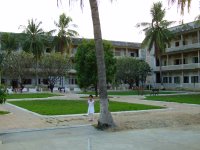 It used to be a school. It became the Khmer Rouge's main detention and interrogation centre. It is now a museum and an eerie, scary place - but children still play in the grounds and some boys were playing volleyball with the attendants at dusk.
It used to be a school. It became the Khmer Rouge's main detention and interrogation centre. It is now a museum and an eerie, scary place - but children still play in the grounds and some boys were playing volleyball with the attendants at dusk.
 Classrooms were turned into interrogation rooms. Each one with a single bed frame, to which the prisoners were tied. And tortured. As we walked through the rooms, our footsteps echoed loudly in the bare rooms - the reverberating cries generated when more than a dozen people were simultaneously interrogated here must have been unbearable to hear, restrained in the holding cells, waiting for your turn. Your turn to scream, and then die. Lasciate ogne speranza, voi ch'intrate.
Classrooms were turned into interrogation rooms. Each one with a single bed frame, to which the prisoners were tied. And tortured. As we walked through the rooms, our footsteps echoed loudly in the bare rooms - the reverberating cries generated when more than a dozen people were simultaneously interrogated here must have been unbearable to hear, restrained in the holding cells, waiting for your turn. Your turn to scream, and then die. Lasciate ogne speranza, voi ch'intrate.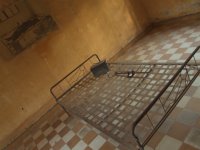
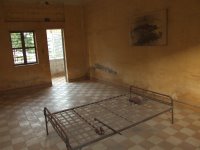
When the Vietnamese soldiers found Toul Sleng, they photographed what they found - a corpse on each bed, the implements of its torture strewn around the room. The museum now displays these artifacts in situ, along with a copy of each soul-sapping photo. The bodies of the 14 victims they found are buried in the school yard.
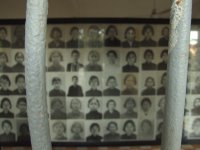
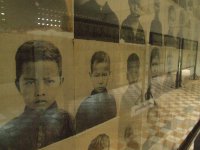
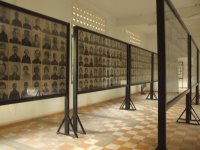
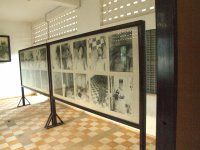
Like the Nazis, the Khmer Rouge kept detailed records of every person processed at Toul Sleng. This included before and after photos as well as biographical details and the prisoners' confessions.
The before photos are haunting, children and adults peering out from behind the glass of history. Racks and racks of them. The after photos are chilling - this museum has not been designed for a squeamish audience.
 These long poles with shackles were used to pack the prisoners into the dormitories. Side by side, not allowed to move or talk, or drink or fight off the mosquitos. Hands of one row tied to the hands of the next.
These long poles with shackles were used to pack the prisoners into the dormitories. Side by side, not allowed to move or talk, or drink or fight off the mosquitos. Hands of one row tied to the hands of the next. This second photo is an artist's impression of the dorm.
This second photo is an artist's impression of the dorm.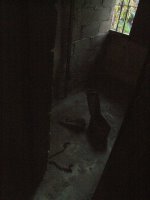 Luxury. An individual holding cell. It's dark because the sun is setting outside. Harvey and I hurry on, seeing and reading what we can until there is nothing left. We leave in near silence, emotionally exhausted. Quietly appreciating anew that we were born in the years and countries that we were. These poor souls did not share our fortune.
Luxury. An individual holding cell. It's dark because the sun is setting outside. Harvey and I hurry on, seeing and reading what we can until there is nothing left. We leave in near silence, emotionally exhausted. Quietly appreciating anew that we were born in the years and countries that we were. These poor souls did not share our fortune.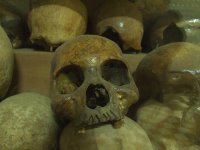


2 Comments:
your last 3 posts are very inspiring. the memories of war should act as a living reminder to mankind of what we are capable of. I wish my time could be spend on doing more good to mankind too.
I think Harvey caught my feelings as well in his blog. He was talking about the killing fields, where there is a sign saying "these people had bodies of men but demons' souls".
I think that's evading the reality. These were men, just like us. We all have the capacity to do great as well as terrible things, and need to accept that - then make the right choices.
Post a Comment
<< Home